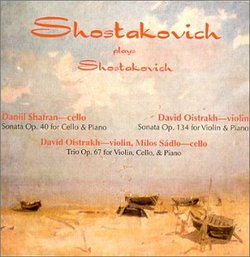Amazon.comIt is always salutary to hear Shostakovich perform his own music. If his own performances are any indication of how he intended his music to be played, then current performances of his music are much too slow--and much too serious. Compare the composer's own, never-before-released recording of the Violin Sonata with David Oistrakh (taped in the violinist's apartment in December 1968, just after the work was completed) with the famous one of the official world premiere a few months later. That performance, in which Oistrakh (to whom the work was dedicated) was joined by Sviatoslav Richter, is still available as part of BMG's five-disc David Oistrakh Edition and is irreplaceable. But Shostakovich's tempos in the march theme of the first movement bring an element of unexpected humor to what, even in the Oistrakh-Richter reading, has always seemed unrelievedly grim. Shostakovich, whose playing was by then impaired by his polio, sometimes struggles with the notes. No such qualifications attach to the 1947 performance of the Piano Trio in E Minor (with Oistrakh and cellist Milos Sadlo) and the 1946 recording of the Cello Sonata in D Minor, in which Shostakovich partners with Daniel Shafran. The Trio, otherwise available only in a somewhat sanitized transfer in Vol. I of Doremi's David Oistrakh Collection, is played with a brutal energy that makes other versions sound sentimental, even naive. The surprisingly well-recorded performance of the Cello Sonata is better, as well as faster, than the celebrated one made 16 years later by the composer with Mstislav Rostropovich. Shafran's cello playing is powerful without sounding ponderous, and poetic without a trace of affectation. His performance is also filled with imaginative touches--such as the eerie timbral effects created by the way he accelerates during the scherzo's glissandi. The composer must have loved the zest with which Shafran played his music, and listeners will, too. --Stephen Wigler


 Track Listings (11) - Disc #1
Track Listings (11) - Disc #1